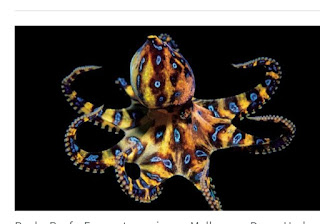The Blue-Ringed Octopus
The blue-ringed octopus, a small and captivating creature, is both adorable and incredibly dangerous. It is best admired from a distance to avoid its venomous nature.join
Living in the sea, the blue-ringed octopus is among the most remarkable creatures. It can be found in the warm and shallow waters of the Pacific, a vibrant underwater world that spans from Australia to Japan. Despite its petite size, fitting in the palm of your hand, this octopus possesses a mesmerizing beauty. However, one should not be deceived by its enchanting appearance, as it carries a venomous sting that can take down 26 humans within minutes.
Meet the blue-ringed octopus (Hapalochlaena sp.), one of the most beautiful cephalopods in the world, which is absolutely stunning yet lethal to touch.
Let's explore some key questions about the blue-ringed octopus:
1. How big are they?
These octopi are tiny creatures, measuring up to 20 cm in length. However, on average, they tend to be around 12 cm long. It is worth noting that there are at least 10 species of blue-ringed octopuses in the world, although only four of them have been scientifically described. Interestingly, despite their small size, all ten species carry enough venom to kill an average human.
2. What do they eat?
Blue-ringed octopuses feed on a variety of prey, including small fish, crabs, and shrimp. They are skilled predators, cunningly ambushing their prey and capturing it with their sharp beaks.
3. Where do they live?
These remarkable creatures inhabit the warm and shallow waters of the Pacific Ocean. They can be found in regions stretching from Australia to Japan, where the marine environment is rich and diverse.
4. How do they hunt?
Blue-ringed octopuses employ stealth and patience when hunting. They carefully choose their target and then swiftly and accurately strike, rendering their prey defenseless with a combination of venom and powerful grasping arms.
5. How do they reproduce?
Blue-ringed octopuses follow a unique reproductive process. At just one year old, they reach sexual maturity and, sadly, their lives are short-lived. Typically solitary creatures, the octopuses hide among hermit crabs or in crevices until they mature. Once sexually mature, males venture out in search of suitable females. During mating, the male inserts his specialized "arm-penis," known as the hectocotylus, into the female's mantle cavity, which houses not only the reproductive organs but also the brain, stomach, intestines, kidney, liver, and gills. After successful mating, the female lays between 50 to 100 eggs. However, these eggs are venomous. Tragically, both males and females die shortly after mating. While females protect their brood with great fervor, they eventually perish after their eggs hatch.
6. Are Blue-Ringed Octopuses endangered or rare?
Blue-ringed octopuses are not considered endangered or rare, although their unique nature and habitat make them a fascinating subject of study and conservation efforts.
Blue-ringed octopuses derive their name from the blue rings that adorn their bodies. However, it is important to note that these octopuses do not always display their recognizable blue-ringed pattern. Instead, they reveal these captivating markings when feeling vulnerable or threatened. Thus, their name can be quite misleading.
While possessing adorable and venomous blue rings, blue-ringed octopuses lack the ability to squirt ink, a common characteristic of most octopuses. In situations reminiscent of an Animal Planet-style showdown, blue-ringed octopuses resort to using their numerous arms to slap each other. Interestingly, the venom produced by the blue-ringed octopus has no effect on other members of its own species. They are immune to each other's venom. Unfortunately, this venom poses a significant threat to humans, and to date, there is no known anti-venom available.kk
Blue-ringed octopuses are not the only creatures in the animal kingdom with unique venom. The particular toxin present in blue-ringed octopuses, called tetrodotoxin, was first discovered in pufferfish. Remarkably, it is not exclusive to marine creatures but can also be found in amphibians such as frogs and newts.The poison is strong and fast-acting. When bitten by a blue-ringed octopus, one's voluntary muscles become paralyzed, though the victim remains fully conscious. In humans, the reaction can be fatal, as death is usually triggered by a lack of oxygen.
Octopuses of different species are sold as pets.Tank requirements for these octopuses vary.The recommended water temperature is also determined.




.jpeg)
.jpeg)
.jpeg)
.jpeg)
No comments:
Post a Comment